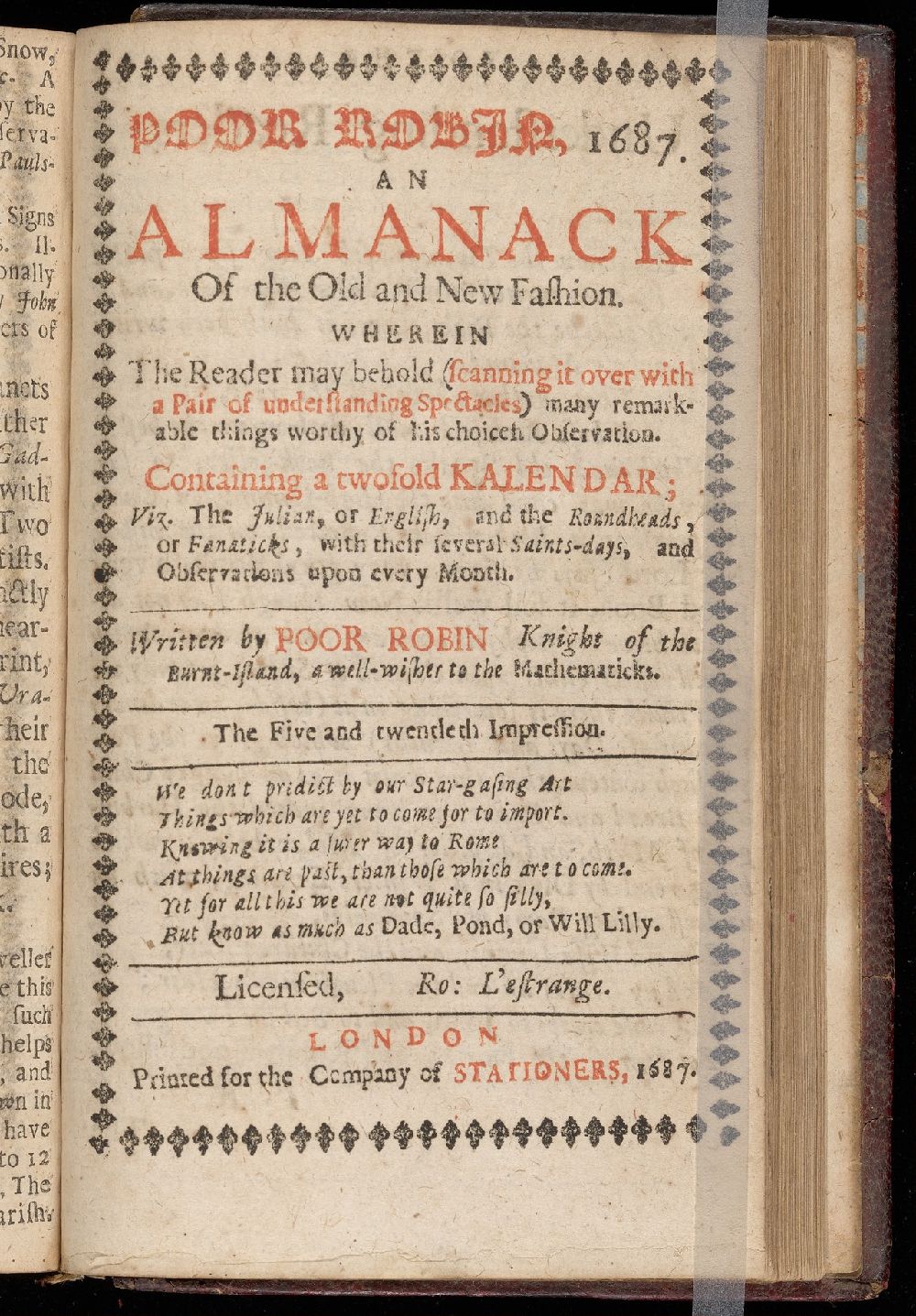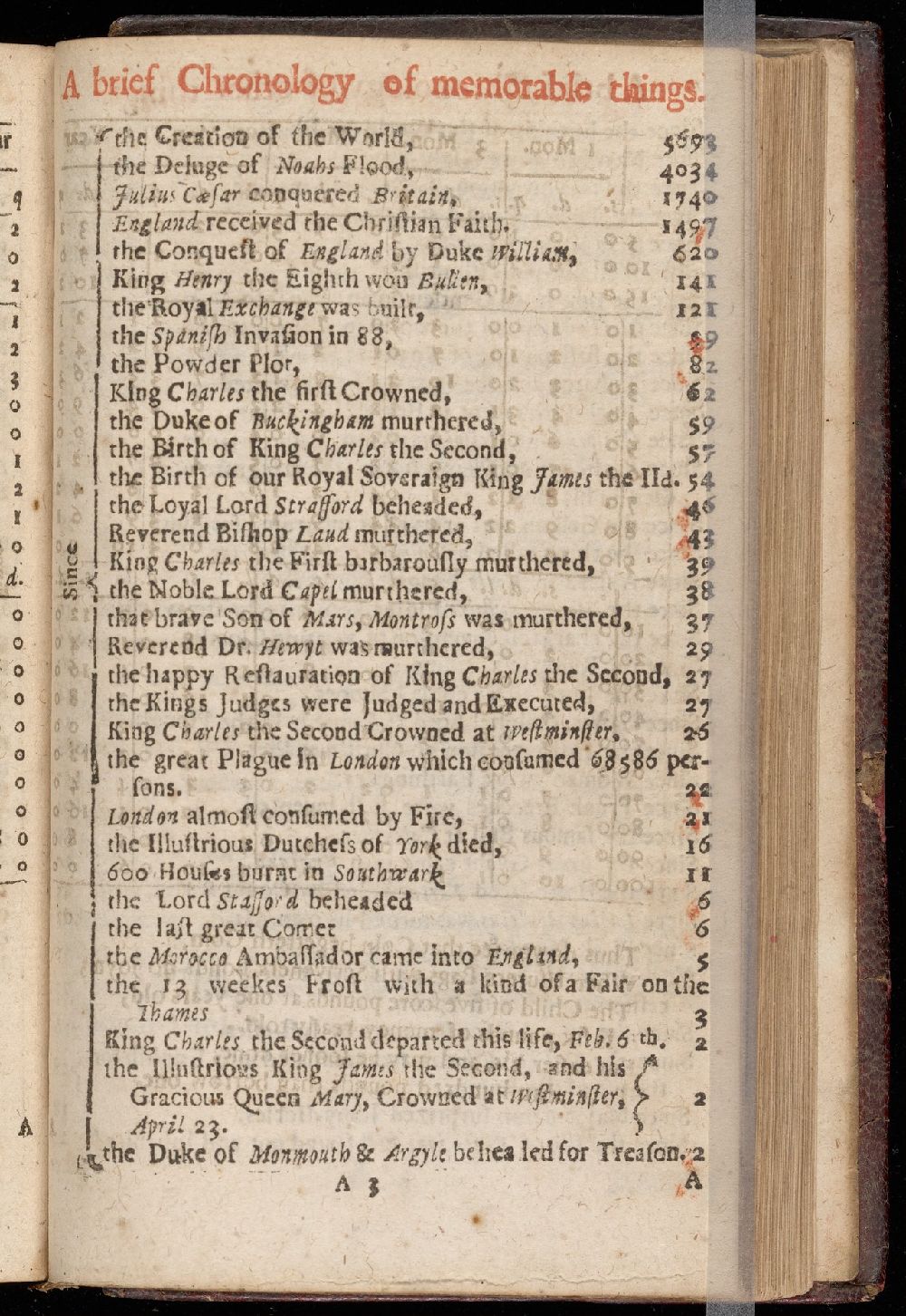Almanacs
Pat Rogers, University of South Florida
February 2024
The English book trade was centred on London, its mainspring was for long the Stationers’ Company, and the group’s power rested in large measure on certain monopoly rights. Along with the Bible and the Book of Common Prayer, the Company’s most valuable asset derived from the production of hugely popular almanacs. Collectively, these were the most Important forms of intellectual property in the eighteenth century. In the era when astrology maintained a strong grip on the popular imagination, the printing of almanacs and prognostications was granted to the King’s printer and then to the Company, who were awarded a perpetual monopoly in 1603. For booksellers and compilers licensed by the Stationers to issue their own almanacs, it was a major source of income. Total sales in this period amounted to figures approaching 400,000 every year, comparable to those of each of the religious works. The most successful of these could reach a circulation of up to 80,000, with the frequent market leader known as Old Moore’s Almanac eventually rising to a peak of over 500,000 in the 1830s. The readership would be higher in some cases, since copies might be shared around a partly literate audience.
It was not until 1775 that the Company was forced by the pressure of court decisions to relinquish the monopoly. By that time, its broader control over the industry had weakened, and there was a declining faith in one of the historic almanac’s main props, that is the science of astrology as then conceived. Gradually over the decades, too, the frenetic political and religious content that marked the seventeenth-century almanac had become less prevalent. For the earlier period, the best guide remains Bernard Capp’s influential study, which shows how deeply astrological thinking permeated what might be called the key mass medium of the day. It may be supplemented for the following age, lasting up to about 1850, by the massive research of William St. Clair on the reading nation. St. Clair was able to situate this highly specialised and indeed almost unique branch of publishing within the large political and commercial landscape of the nation. As he puts it, “In exchange for its continuing cooperation with the state, the main collective institution of the book industry was thus granted the right to take a rent every year in perpetuity from all of the wide range of economic activities and religious and cultural practices which depended upon participants having access, each year, to the printed information which almanacs contained.”
As for those contents, they represented a stylised and hardly varying selection of topics that were repeated just as regularly as the seasons (which figured heavily in a publication for an agrarian society) over the course of many generations. Once again, St. Clair provides a useful summary:
Almanacs gave the dates of the monthly and annual fairs held in the larger towns, essential information for an agricultural economy. They gave information about the tides on which all sea-borne and much river-borne trade depended. They set out the dates of church festivals, used to recommend the best rimes for crop planting and harvesting, as well as for the renewals of labour contracts, the collection of tithes, taxes and rents, and for scheduling religious festivals. They also set out the dates of law and university terms. The almanac monopoly appears to have produced an income to the industry of several hundred per cent on the manufacturing costs of the books every year on sales of several hundred copies.
Commonly, almanacs appeared in two forms, either as a single large sheet, capable of being displayed on a wall, or as a small pamphlet, which most often took the form of three octavo sheets (48 pages).
Despite continual efforts by outsiders to break the monopoly with private versions, the official group of licensees managed to keep a fairly strong hold on their valuable rights until the last quarter of the eighteenth century. One exception is the Oxford Almanack, where the University was able to bypass the embargo and reach agreements with the Stationers to produce its own slightly idiosyncratic model, which appeared every year from 1676 to 2019.
The most influential of earlier astrologers was William Lilly (1602–1681). Other notable makers of the almanac in its heyday were Richard Allestree (d.c. 1643); John Booker (1603–1667); Vincent Wing (1619-68); Henry Coley (1633-1704); John Gadbury (1627–1704); John Partridge (1644–1714); and Francis Moore (1657–715), author of Vox Stellarum: or a Loyal Alamanck, later known in its still existing incarnation as Old Moore’s Almanac (“Loyal” means pro-Hanoverian). Gadbury and Partridge were active in an era of the most intense political and religious controversy, embodying the attitudes of respectively Tory/Catholic and Whig/Protestant opinion.
All these individuals were based in London and issued their predictions from the city. An especially interesting case is that of William Salmon (1644–1713), who had several careers as well as that of an astrologer. He was of the empiric practitioners regarded by many in his own time as a pur sang fraudster: indeed, the physicians whom he opposed in their struggle with the apothecaries dubbed him “king of the quacks.” He was sufficiently well known among those taking part in the controversy between the Royal College of Physicians and the Society of Apothecaries to earn a mention in Samuel Garth’s poetic treatment of the affair, The Dispensary (1699). Salmon had begun his career near the Smithfield Gate of St. Bartholomew’s Hospital: he later operated from an address at the “Blue Balcony by the Ditch side near Holborn Bridge.” The death of “Dr. Salmon, of Fleet-Ditch, and of Quackish Memory” was recorded in the press on 18 December 1712. His wife Anne continued to prepare and sell his medicines, despite the fact that he complained of her behaviour in his will and left her only £50 out of a very considerable estate. Over the years, he wrote books on a wide variety of topics, including medicine, surgery, pharmacology, alchemy, botany and cooking. Many of these treatises were nakedly derivative, involving extensive abridgement or translation from earlier sources. Among the more notable is his translation of the Pharmacopœia Londinsensis, originated by the College of Physicians. From 1691 he compiled The London Almanack, which "turned into an extended advertisement for his many medicines” (Paul Kléber Monod). A representative title reads, “The London almanack. For the year of Our Lord, 1701. For the year of the world, 5701. For the year of His Majesties reign. 13. Containing I. The moon's rising, setting and southing. II. The time of high water at London-Bridge…By William Salmon, M.D. living by Black-Friars-Stairs, London.”
This particular issue carries a long ad for his Balsam di Chile, which went with a variety of elixirs and powders. Alongside the astrological data for each month came recipes and cures for a given ailment.
From the start of its history, the almanac had encountered parodies and satires on its methods and procedures. The most longlasting of these was the burlesque version called Poor Robin’s Almanack, issued from 1663 by William Winstanley (?1628–1698) and running for more than a century with a mixture of faux prophecy and genuine Information. It was in part the model for Benjamin Franklin’s publication under a closely related name (1732–1757). However, the most famous of comic ripostes to astrologers came with Jonathan Swift’s pamphlets directed against John Partridge in 1708. The victim was able enough in many ways, having worked himself up from shoemaking to qualifying as a doctor. But he offered an easy target for Swift with his violent Whiggery, his strident anti-papist rhetoric, his apocalyptic raids on scripture, and his generally hectic style. These brief “predictions” convinced many readers that Partridge really had died, as they claim, and led to a loss of his reputation from which he never fully recovered. As Bernard Capp says, Swift was able to expose the “platitudinous ambiguity” of the almanacs, and to denounce “their groundless and partisan political predictions.”
Partridge himself survived for a few more years, and the almanac long outlasted Swift. But it became increasingly a repository of solid fact, with the more bizarre forecasts of wars, plagues, revolutions and natural disasters excised. The farmer could still find a guide to seasonal activities, churchgoers could still look up the religious calendar, mariners could still calculate the time of high water in various ports. and merchants could still consult tables of interest. It remained possible to study the list of kings and queens of England, to bone up on signs of the zodiac, and to plot the positions of stars. Almanacs, in short, were now a more reliable guide to the state of the nation, the world and the cosmos. For a modern reader, though, they are perhaps a little less fun.
  Poor Robin 1687: an almanack of the old and new fashion: wherein the reader may behold (scanning it over with a pair of understanding spectacles) many remarkable things worthy of his choicest observation: containing a two-fold kalendar, viz. the Julian, or English, and the roundheads, or fanaticks, with their several saints-days, and observations upon every month (1687). Beinecke Rare Book and Manuscript Library 2013 1188. These images are in the public domain. |
The foundational work is Bernard Capp, Astrology and the Popular Press: English Almanacs 1500-1800 (1979). For relations with the book trade, see William St. Clair, The Reading Nation in the Romantic Period (2004). The broader context is best studied in a magisterial work by Keith Thomas, Religion and the Decline of Magic (1991).